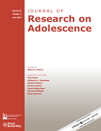
Adolescence is a transitional stage of physical and psychological development that generally occurs during the period from puberty to legal adulthood. Adolescence is usually associated with the teenage years, but its physical, psychological or cultural expressions may begin earlier and end later. For example, puberty now typically begins during preadolescence, particularly in females. Physical growth and cognitive development can extend into the early twenties. Thus, age provides only a rough marker of adolescence, and scholars have found it difficult to agree upon a precise definition of adolescence.

Culture is broadly defined as shared symbolic systems and the processes of maintaining and transforming those systems. These include, but are not limited to, the culture's values, goals, behaviors, beliefs, forms of identity expression, and other shared practices. Youth culture refers to the societal norms of children, adolescents, and young adults. Specifically, youth culture comprises the processes and symbolic systems that are shared by the youth demographic and are distinct from those of adults in the community.

In sociology, a peer group is both a social group and a primary group of people who have similar interests (homophily), age, background, or social status. The members of this group are likely to influence the person's beliefs and behaviour. Peer groups contain hierarchies and distinct patterns of behavior. In a high school setting for example, 18 year olds are a peer group with 14 year olds because they share similar and paralleled life experiences in school together. In contrast, teachers do not share students as a peer group because teachers and students fall into two different roles and experiences.

Youth is the time of life when one is young, and often means the time between childhood and adulthood (maturity). It is also defined as "the appearance, freshness, vigor, spirit, etc., characteristic of one who is young". Its definitions of a specific age range varies, as youth is not defined chronologically as a stage that can be tied to specific age ranges; nor can its end point be linked to specific activities, such as taking unpaid work or having sexual relations.
Youth & Society is a peer-reviewed academic journal that publishes papers in the field of Sociology. The journal's editor is Marc Zimmerman. It has been in publication since 1969 and is currently published by SAGE Publications.

Egocentrism is the inability to differentiate between self and other. More specifically, it is the inability to accurately assume or understand any perspective other than one's own.

Ephebiphobia is the fear of youth. First coined as the "fear or loathing of teenagers", today the phenomenon is recognized as the "inaccurate, exaggerated and sensational characterization of young people" in a range of settings around the world. Studies of the fear of youth occur in sociology and youth studies. It is distinguished from pedophobia by being more so focused on adolescents than prepubescent children.

Suicidal ideation is thinking about, considering, or planning suicide. It is not a diagnosis, but is a symptom of some mental disorders and can also occur in response to adverse events without the presence of a mental disorder.
Adolescent medicine also known as adolescent and young adult medicine is a medical subspecialty that focuses on care of patients who are in the adolescent period of development. This period begins at puberty and lasts until growth has stopped, at which time adulthood begins. Typically, patients in this age range will be in the last years of middle school up until college graduation. In developed nations, the psychosocial period of adolescence is extended both by an earlier start, as the onset of puberty begins earlier, and a later end, as patients require more years of education or training before they reach economic independence from their parents.
Teenage rebellion is a part of human development in young adults in order for them to develop an identity independent from their parents or family and a capacity for independent decision-making. They may experiment with different roles, behaviors, and ideologies as part of this process of developing an identity. Teenage rebellion has been recognized within psychology as a set of behavioral traits that supersede class, culture, or race; some psychologists, however, have disputed the universality of the phenomenon. According to Terror Management Theory, the child's allegiance to parental authority and worldviews can weaken after the discovery that parents, like themselves and everyone else, are mortal. This realization creates an unconscious need for security that is broader than what the parents alone provide. This can lead to new cultural allegiances, in the search for a more enduring sense of meaning. Teenagers seek to perceive themselves a valued contributor to aspects of culture that more convincingly outlive or transcend the mortal individual's lifespan. However, since the parents also instill their cultural beliefs onto the child, if the child does not come to associate their parents‘ mortality with their cultural beliefs, the chances of rebellion decrease.
Identity formation, also called identity development or identity construction, is a complex process in which humans develop a clear and unique view of themselves and of their identity.
Youth studies is an interdisciplinary academic field devoted to the study of the development, history, culture, psychology, and politics of youth. The field studies not only specific cultures of young people, but also their relationships, roles and responsibilities throughout the larger societies which they occupy. The field includes scholars of education, literature, history, politics, religion, sociology, and many other disciplines within the humanities and social sciences. Youth studies encourages the understanding of experiences that are predominantly manifested among young people, generalized phenomenon and social change. The majority of 15- to 24-year-olds in 2008 lived in developing countries. The definition of youth varies across cultural contexts. The social experience and organization of time and space are important themes in youth studies. Scholars examine how neoliberalism and globalization affect how young people experience life, including in comparison to previous generations.
Archives of Disease in Childhood is a peer-reviewed medical journal published by the BMJ Group and covering the field of paediatrics. It is the official journal of the Royal College of Paediatrics and Child Health.
Sexual fluidity is one or more changes in sexuality or sexual identity. Sexual orientation is stable and unchanging for the vast majority of people, but some research indicates that some people may experience change in their sexual orientation, and this is more likely for women than for men. There is no scientific evidence that sexual orientation can be changed through psychotherapy. Sexual identity can change throughout an individual's life, and may or may not align with biological sex, sexual behavior or actual sexual orientation.

Transgender youth are children or adolescents who do not identify with the sex they were assigned at birth. Because transgender youth are usually dependent on their parents for care, shelter, financial support, and other needs, transgender youth face different challenges compared to adults. Professional medical associations state that appropriate care may include supportive mental health care, social transition, and puberty blockers, which delay puberty and the development of secondary sex characteristics to give children time to make decisions about more permanent courses of action. Most children with gender dysphoria end up identifying with their biological sex after reaching puberty, though if gender dysphoria does continue into adolescence it is far more likely to persist into adulthood. However, the evidence offered to support this has been disputed.

The Journal of Early Adolescence is a peer-reviewed academic journal that publishes papers in the field of Psychology. The journal's editor is Alexander T Vazsonyi. It has been in publication since 1981 and is currently published by SAGE Publications.
Religious identity is a specific type of identity formation. Particularly, it is the sense of group membership to a religion and the importance of this group membership as it pertains to one's self-concept. Religious identity is not necessarily the same as religiousness or religiosity. Although these three terms share a commonality, religiousness and religiosity refer to both the value of religious group membership as well as participation in religious events. Religious identity, on the other hand, refers specifically to religious group membership regardless of religious activity or participation.

Child Development is a bimonthly peer-reviewed academic journal covering developmental psychology from the fetal period to adolescence. It was established in 1930 and the editor-in-chief is Cynthia García Coll. It is published by Wiley-Blackwell on behalf of the Society for Research in Child Development. The journal publishes original contributions on topics in child development from the fetal period through adolescence.

Journal of Research on Adolescence is a peer-reviewed academic journal published quarterly by Wiley-Blackwell on behalf of the Society for Research on Adolescence. The editor-in-chief is Nancy G. Guerra. The journal covers research on adolescence using "both quantitative and qualitative methodologies applied to cognitive, physical, emotional, and social development and behavior". According to the Journal Citation Reports, the journal has a 2011 impact factor of 1.989, ranking it 6th out of 38 journals in the category "Family Studies" and 27th out of 67 journals in the category "Psychology, Developmental".
British Journal of Developmental Psychology is a quarterly peer-reviewed academic journal published by Wiley-Blackwell on behalf of the British Psychological Society. The journal was established in 1983. The journal covers developmental psychology topics such as social, emotional and personality development in childhood, adolescence and adulthood, the development of language and atypical development.










